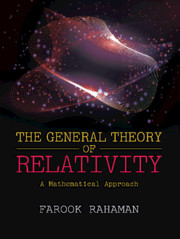Book contents
- Frontmatter
- Dedication
- Contents
- List of Figures
- List of Tables
- Preface
- Acknowledgments
- Chapter 1 Tensor Calculus — A Brief Overview
- Chapter 2 Geodesic
- Chapter 3 Einstein Field Equations
- Chapter 4 Linearized Gravity
- Chapter 5 Lie Derivatives and Killing’s Equation
- Chapter 6 Spacetimes of Spherically Symmetric Distribution of Matter and Black Holes
- Chapter 7 Particle and Photon Orbits in the Schwarzschild Spacetime
- Chapter 8 Causal Structure of Spacetime
- Chapter 9 Exact Solutions of Einstein Equations and Their Causal Structures
- Chapter 10 Rotating Black Holes
- Chapter 11 Elementary Cosmology
- Chapter 12 Elementary Astrophysics
- Appendix A Extrinsic Curvature or Second Fundamental Form
- Appendix B Lagrangian Formulation of General Relativity
- Appendix C 3+1 Decomposition
- Bibliography
- Index
Chapter 3 - Einstein Field Equations
Published online by Cambridge University Press: 24 March 2021
- Frontmatter
- Dedication
- Contents
- List of Figures
- List of Tables
- Preface
- Acknowledgments
- Chapter 1 Tensor Calculus — A Brief Overview
- Chapter 2 Geodesic
- Chapter 3 Einstein Field Equations
- Chapter 4 Linearized Gravity
- Chapter 5 Lie Derivatives and Killing’s Equation
- Chapter 6 Spacetimes of Spherically Symmetric Distribution of Matter and Black Holes
- Chapter 7 Particle and Photon Orbits in the Schwarzschild Spacetime
- Chapter 8 Causal Structure of Spacetime
- Chapter 9 Exact Solutions of Einstein Equations and Their Causal Structures
- Chapter 10 Rotating Black Holes
- Chapter 11 Elementary Cosmology
- Chapter 12 Elementary Astrophysics
- Appendix A Extrinsic Curvature or Second Fundamental Form
- Appendix B Lagrangian Formulation of General Relativity
- Appendix C 3+1 Decomposition
- Bibliography
- Index
Summary
Introduction
To describe how matter and energy change the geometry of spacetime, Einstein proposed a new theory of gravitation, known as the general theory of relativity. This theory is characterized by a set of dynamical equations, dubbed as Einstein field equations, which demonstrate the fundamental interaction of gravitation as a result of spacetime being curved by mass and energy. Albert Einstein published this new theory of gravitation in 1915 as a tensor equation. The motion of a body in this gravitational field is explained almost perfectly by the geodesic equations.
Einstein used three principles to develop his general theory of relativity.
1. Mach's Principle: Ernest Mach gave some ideas without any proof and arguments that are known as Mach's principle. There are several forms of Mach's principle. Some forms are executed in general relativity and others are not.
(i) Geometry is determined by the matter distribution.
(ii) If matter does not exist then the geometry will not occur.
These statements are not absolutely true as there are vacuum solutions of the Einstein field equations (see later).
(iii) The local inertial frame is entirely persistent by the dynamical fields in the universe.
Actually, this form of Mach's principle is the key idea of Einstein.
2. Equivalence Principle: The laws of physics are the same in all inertial systems. No preferred inertial system exists.
(The above statements, i.e., containing the words “Laws of Physics” is referred to strong equivalence principle and when “Law of Physics” is replaced by “Law of motion of freely falling particles” then the principle is referred to weak principle of equivalence.)
This principle reveals that one can eliminate gravity locally by falling freely in a gravitational field and regain special relativity.
3. Principle of covariance: The law of gravitation should be independent of the coordinate system. This means the field equations of gravitation should be invariant in form with respect to arbitrary coordinate transformations. In other words, the field equations should have a tensorial form.
Three Types of Mass
1. Inertial mass: This mass is a measure of the body's resistance to change its state, i.e., either in a rest position or in motion. The mass appears in Newton's second law F = mIf, i.e., here mI is known as inertial mass.
- Type
- Chapter
- Information
- The General Theory of RelativityA Mathematical Approach, pp. 61 - 84Publisher: Cambridge University PressPrint publication year: 2021



